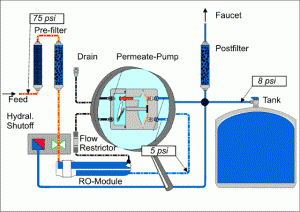How Much Do Permeate Pumps Contribute to TDS Creep in Home RO Units?
by Gene Franks
The permeate pump has become a popular option for undersink reverse osmosis units. The “pump” doesn’t increase inlet pressure, as an electric booster pump does, but enhances RO performance by isolating the RO membrane from back pressure from the storage tank. It uses energy taken from the brine (drain) flow to power the product water (permeate) into the pressurized storage tank. The permeate pump saves water, no doubt about it, and is assumed to improve water quality, as measured by TDS performance, as well.
One of the controversial issues with the permeate pump is whether it should be installed with or without a standard auto shutoff valve (ASO), the device that turns standard RO production off when the unit’s storage tank is full.
 Mysterious action of the non-electric permeate pump. Click on picture for animated version.
Mysterious action of the non-electric permeate pump. Click on picture for animated version.
If installed without a shutoff valve, the pump itself shuts down production when the tank is full. With this arrangement, the tank is filled to almost 100% of the pressure of the tap water. The high tank pressure is especially advantageous in low pressure situations, such as wells set up to send pressures as low as 30 or 40 psi to the home.
If the permeate pump is installed with the regular shutoff valve, the valve shuts down production when the storage tank pressure reaches about 2/3 of the tap water pressure. I
The reason most permeate pumps are now installed with the ASO in place, in spite of giving up a little pressure at the faucet, is to combat a phenomenon called “TDS creep” that occurs when the RO unit sits unused. Without the ASO to form a physical wall between incoming tap water and the RO membrane, the dissolved solids count “creeps” upward because the natural forces of osmosis are still at work.
TDS stands for “total dissolved solids” and the TDS count is a theoretical sum of all the minerals dissolved in the water. Testing TDS is a standard way to evaluate reverse osmosis performance. The lower the TDS reading, the better the unit is working.
I decided to give the TDS creep problem a real world test with my home RO unit running with three different configurations to see if much dreaded TDS creep really matters significantly in home units. The chart below shows the three formats and the results.
I took 16 tests in each of three categories, all in the morning, testing the first water out of the unit after a night of inactivity. TDS creep occurs when the unit is not producing water. In all, the testing spread over 12 consecutive days. I tested the first glass, the second glass, the third glass, and then emptied the tank half way and took a test there. As expected, the first and second glasses usually but not always had the highest TDS readings no matter what format the RO unit was arranged in.
Testing wasn’t done with high dollar lab equipment but with my trusty HM TDS-3 handheld tester, the same tester we send out with our Black and White RO units.
A tap water TDS reading was taken before each group to provide a “base line” and results below are expressed as “% rejection” rather than actual TDS numbers. [“Percent rejection” means tap water TDS minus RO TDS divided by tap water TDS. It expresses the percentage of the total dissolved solids (minerals) in the water that are being rejected by the membrane. The higher the percentage, the better the membrane is working.]
The column on the right is the significant figure. It shows the average of all 16 tests taken in the category.
|
Product Setup |
Lowest Reading–% rejection |
Highest Reading–% rejection |
Average — % rejection |
|
Permeate Pump with Auto Shutoff Installed |
89% | 96% | 93.50% |
|
Permeate Pump with Auto Shutoff Absent |
89% | 97% | 91% |
|
Standard Setup: Auto shutoff, no permeate pump. |
92% | 97% | 95.25% |
As expected, the “first water out in the morning” TDS performance of the unit with permeate pump was better with the shutoff valve than without. It was totally unexpected, however, that the best performance of all was the standard setup unit with the conventional shutoff system and no permeate pump. I have no explanation for this, but I should mention a couple of variables. One is that the membrane used is the GRO 50/50, a stingy water-saver that puts out a much reduced brine flow to drive the pump. The pump seems to run fine with the GRO, but starvation of brine water to power the pump might matter. Also, the pump itself is an older version ERP 1000, and the newer, quieter ERP 500 might be a better match for the membrane.
The final word, though, is that although the TDS performance of the permeate pump unit with the shutoff valve seems a bit better, for residential units with lots of stop and go use, I doubt that the difference is worth worrying about. This tiny trial certainly doesn’t give a definitive answer, but I suspect the result from my home unit is typical of what happens in most home installations.




